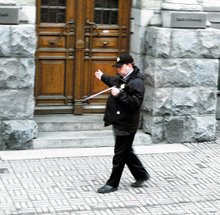Is Sniffex really the first device of its kind? It is a handheld device with a telescoping antenna that freely pivots to point to the target material, explosives.
The Quadro Tracker was a handheld device with a telescoping antenna that would freely swivel, and point to the target material. It was exposed by James Randi more than a decade ago in 1995/1996, before the Department of Justice prosecuted the founders of the company.
http://skepdic.com/quadro.html
http://www.reason.com/news/show/30037.html
http://www.ih2000.net/ira/quad0422.htm
In 1998 the DKL Lifeguard was a rod that allegedly could track people for search and rescue operations or during a manhunt. It too looked a lot like a dowsing rod. Here is a press release and the results of the testing by Sandia National Laboratories:
http://www.sandia.gov/media/hudet.htm
http://infoserve.sandia.gov/sand_doc/1998/980977.pdf
Next came the MOLE Detection System, which appears to be just a reincarnation of the Quadro Tracker. It had a freely pivoting antenna that the user would walk around with, and the antenna would point to the target material, such as explosives. Sandia National Laboratories tested the MOLE system in 2002 to see if it could locate explosives. How well did it work? See for yourself in another PDF file:
http://www.justnet.org/Lists/JUSTNET%20Resources/Attachments/440/moleeval_apr02.pdf
More on the Alpha 6, ADE 100, ADE 650, ADE 651 and MOLE
James Randi and his readers have now exposed even more renamed versions of the Quadro Tracker. If you will remember, the sellers of the Quadro Tracker were arrested in USA for fraud. The Alpha 6 Molecular Detector from SCANDEC and the ADE 100, ADE 101, ADE 650, ADE 651 from ATSC UK seem to be the same dowsing rods with new names.
http://www.randi.org/jr/2007-05/052507.html#i4
http://www.emcom.co.za/products/comstrac.html
UPDATE Time Magazine reported in 2002 on the United States Department of Energy wasting funds on dowsing rods. Government funds being wasted on dowsing does not seem to be a new problem, after all, we were warned about this fraud 90 years ago! "Further testing of dowsing...would be a misuse of public funds."
— U.S. Geological Survey report, 1917
Regarding the most recent spending: "The Inspector General's conclusion: 'Had a peer review been performed prior to testing, the Department could have avoided spending $408,750 on this technology.'"
http://www.time.com/time/columnist/jaroff/article/0,9565,231110,00.html
Do any of these look similar?

Quadro Tracker


ADE 650

DKL Lifeguard

MOLE Detector

Sniffex

Alpha 6

ADE 650 or 651
More on the Alpha 6, ADE 100, ADE 650, ADE 651 and MOLE
James Randi and his readers have now exposed even more renamed versions of the Quadro Tracker. If you will remember, the sellers of the Quadro Tracker were arrested in USA for fraud. The Alpha 6 Molecular Detector from SCANDEC and the ADE 100, ADE 101, ADE 650, ADE 651 from ATSC UK seem to be the same dowsing rods with new names.
http://www.randi.org/jr/2007-05/052507.html#i4
http://www.emcom.co.za/products/comstrac.html
UPDATE Time Magazine reported in 2002 on the United States Department of Energy wasting funds on dowsing rods. Government funds being wasted on dowsing does not seem to be a new problem, after all, we were warned about this fraud 90 years ago! "Further testing of dowsing...would be a misuse of public funds."
— U.S. Geological Survey report, 1917
Regarding the most recent spending: "The Inspector General's conclusion: 'Had a peer review been performed prior to testing, the Department could have avoided spending $408,750 on this technology.'"
http://www.time.com/time/columnist/jaroff/article/0,9565,231110,00.html
Do any of these look similar?

Quadro Tracker


ADE 650

DKL Lifeguard

MOLE Detector

Sniffex

Alpha 6

ADE 650 or 651

GT200 Detector

A mobile team will come to your home or business to detect explosives with an ADE 650!


Speaking of things looking alike, Is it only me, or does the ProSec logo look a lot like the DEA one?
If you are planning on buying Sniffex, an ADE 100, 101, 650, 651, an Alpha 6, or a MOLE tracker, you should consider conducting your own double-blind test. In a double-blind test, neither the user of the rod nor the observers know where the target object is hidden. This prevents the user from picking up unspoken clues from the observers.

